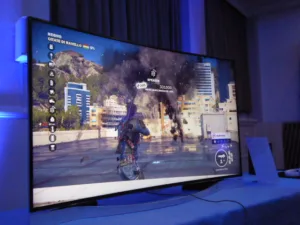We visited a TV launch event in London this week, by Turkish brand Finlux. Finlux used to be a big brand in the Nordics, and really owned the TV market with Nokia. However, these days it is not on the radar of the average UK consumer (or journalist, as we found out when talking to other attendees!), as its TVs are generally not sold in stores. The brand is owned by Vestel – another unfamiliar name to most consumers outside Turkey, but one of Europe’s largest TV makers and the maker of sets for many bigger brands.
Just Cause 3 was being demoed on the 55″ curved set. Although this can be played in UltraHD on a PC, an Xbox was used at the event, so resolution was being upscaled.Held in Woburn House in Euston, Finlux’s event was used to show off the company’s new UltraHD TVs. These are second-generation sets, with differences in content sources, audio and, of course, design.
There are four new TVs in the range, which was being launched that day. They are 43″ (43UT3E310B-T), 49″ (49UT3E310B-T) and 55″ (55UT3E310B-T) flat models, and a 55″ curved display (55UX3EC320S-T). Because Finlux is relatively unknown, the company feels like its main USP must be price – and these were impressive even to us! The flagship curved model, for instance, will usually cost £1,000 ($1,500) – but has a promotional launch price of just £800 ($1,200).
The flat curved set will normally be £700 ($1,050), but is being launched at £600 ($900); the 49″ will cost £600 and is being launched at £500 ($750); and the 43″ will cost £500 and is being launched at £400 ($600). Prices include VAT.
Content was a problem for Finlux in its first UltraHD TVs, so the company has added Netflix and YouTube UltraHD apps to the TVs. These are pre-installed, and there are dedicated buttons on the remote control to open them. The TVs are able to play HEVC and VP9 content, as well as accepting UltraHD content through a USB stick – a big plus for demonstration models (the company is considering bundling a USB stick with pre-loaded content with the sets) and user-generated content. MP4, VP9, MKV and MOV files can all be played through USB, at 30fps.
As well as three USB 2.0 ports, the TVs have four HDMI ports. Of these, three can handle UltraHD signals at 60fps and support HDCP 2.2. Finlux’s first-generation models used HDCP 1.4. They also feature DTS TruSurround audio – another new feature, which the brand wants to use to distinguish its TVs from competitors’. A range of headphones, produced with DTS, was also being launched at the event.
All of the flat sets share specifications. They are edge-lit, with 350 cd/m² of brightness and a 1,200:1 contrast ratio. Response time is 6ms and refresh rate is 50Hz. This did cause noticeable motion blur when viewing fast-paced sports content on the 49″ TV. These sets also feature passive 3D, and are supplied with four pairs of 3D glasses.
Although largely similar to the flat sets, the curved model is the obvious flagship. It has active 3D (and is supplied with two pairs of glasses), a 4,000:1 contrast ratio (this implies the use of a VA panel to us, rather than IPS, and we are checking this with Finlux) and a 100Hz refresh rate. The TV was being used to showcase gaming content (Skysaga and Just Cause 3), and there was no blurring or smearing to be seen. This set also uses a direct-LED backlight. Although we have been unconvinced by curved TVs to date (despite the protestations of our friend, Ray Soneira), Finlux’s set looked very good even when viewed off angle.
All of the sets looked excellent, even to our relatively trained eyes. The combination of premium technology (although they lack features such as HDR) and a low price point are likely to prove very compelling in this year’s shopping season.

